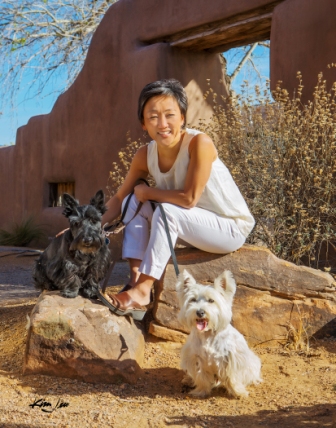The dogs in France

ONE OF THE hardest realities of traveling abroad is seeing how animals are treated in some countries—and not only the poor ones. So it was with happy wonder that I had a completely different view of things on a trip last month to France.
Having lived there in the 1980s, I knew that the French love their dogs. A schtick stays with me of the family dog seated at the dinner table while the wife is begging on all fours underneath. But what I saw in modern-day France is not exactly the Standard Poodle version of our high-dollar, high-anxiety pooch pampering.
French dogs, first of all, seem universally calm. Of course, the not-calm ones are probably kept at home, since the French allow dogs nearly everywhere if they are well behaved. You see them sleeping on café seats, riding in supermarket carts, tucked under an arm in boutiques, even brought food and water in restaurants. You can buy your dog a ticket on the train (at half price). In all cases, these dogs are quiet and obedient, focused on their person, quite unlike any American dog outside the home.
Much as they cherish their dogs, however, the French are not sentimental. They do not fuss over their pets. Dogs and cats are members of the family, but understood to have their own routines and habits befitting their station. Animals are loved as animals, and their presence—like their obedience—is simply taken for granted.
I suspect that’s because pet ownership, like every other aspect of life in France, has developed manners, rules, customs, and traditions that everyone grows up learning alongside the nuances of cheese, wine, and perfume. It is part of the great civilization of which every Frenchman is proud, and will not abandon no matter how much they may love their iPhones and Game of Thrones.
Visit the French countryside, and you will see why they shunned our tastier, juicier American beef fattened on growth hormones. Cycling across Burgundy, my husband and I were amazed to see pasture after pasture of cattle such as one never encounters in the U.S.
These white Charolais spend their days grazing on lush green grass, but most of the time they are not even grazing; they are sitting together in family groups, nuzzling each other, swatting flies, enjoying the fresh air, sometimes stretching out in the sun like a relaxed horse. Every one of them has the curious, intelligent air never seen on a packed Texas feedlot.
Granted, the French have their institutionalized cruelties: the annual foxhunt, which makes Frenchmen rabid; the purveyors of horsemeat we saw at market; the torture of foie gras; dogs kept as penned guards; banged-up barn cats left to fend for themselves. Pets are rarely sterilized, and most animal shelters routinely euthanize strays.
But the refinement of French civilization, I realized, is actually built on a culturally constructed, harmonious interdependence with nature. Food is still mostly grown locally, prepared in traditional fashion, consumed according to custom (not in a car or at a desk), which is probably why obesity is rare. Animals may be treated as beasts of burden, hunters’ quarry, or meat, but the relationship forms part of a natural balance that has stood the test of time. The French excel at training their people, as well as their dogs.
If it is true, as Gandhi said, that the greatness of a nation can be judged by how its animals are treated, the French consistently model their creed of “liberté, egalité, fraternité.” Their animals, no less than their people, find freedom within the limitations of their station.
